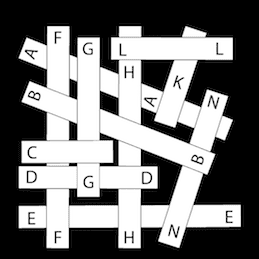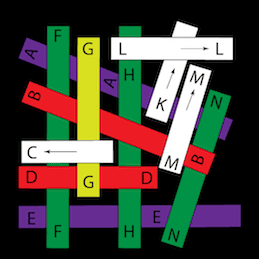This picture represents a bunch of sticks lying on top of a black table. You are looking directly down on the sticks, which are all square in section; that is, their thickness (which you can't see) is exactly equal to their width, which is shown.
You will notice right away that some of these sticks rest directly on the table and are therefore level—as are certain other sticks which rest on them. Bearing this in mind, first make a small cross (x) on each level stick, then answer the following questions:
-
Draw an arrow pointing towards the lower end of each sloping stick. Which sticks are they?
-
Which level stick is highest above the table?
-
Which stick slopes the most?
-
Which stick slopes the least?
-
Does Stick G touch Stick A?
-
Does Stick B touch Stick H?
-
Does Stick M touch Stick A?
-
If stick C were long enough to reach over to Stick B, would it touch B?
-
If a short stick were placed directly under Stick G, touching A and E, would it touch Stick B? Would it touch Stick D?
-
Are Sticks A and B parallel?
-
Are Sticks K and M parallel?

Solution
A and E are level lying on the table; F, H, and N are level lying on A and E; B and D are level lying on F, H, and N; G is level lying on B and D.
-
Draw an arrow pointing towards the lower end of each sloping stick. C, K, L, and M are sloping.
-
Which level stick is highest above the table? G is highest.
-
Which stick slopes the most? C slopes the most.
-
Which stick slopes the least? K slopes the least.
-
Does Stick G touch Stick A? No.
-
Does Stick B touch Stick H? Yes.
-
Does Stick M touch Stick A? Probably not — depends on how far apart A and B are.
-
If stick C were long enough to reach over to Stick B, would it touch B? No, it would not.
-
If a short stick were placed directly under Stick G, touching A and E, would it touch Stick B? Would it touch Stick D? Yes, it would touch both B and D because it would be on the same level as F and H.
-
Are Sticks A and B parallel? This cannot be determined with certainty, but they look everywhere equidistant.
-
Are Sticks K and M parallel? No, K and M have different slopes and are thus skew lines.
